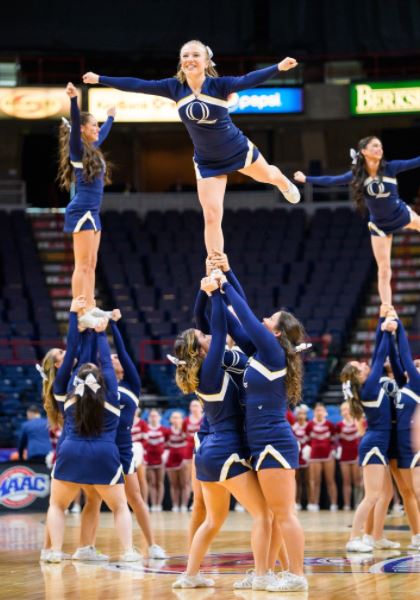Back and Forth
January 7, 2022
Many believe that the OCR should change its tune, as cheerleaders would arguably benefit from access to medical services offered to Title-IX-designated sports.
Cheerleading was second only to football in its number of “direct catastrophic injuries” over more than 30 years, and the American Medical Association (AMA) recommends giving cheer the “sports” title, arguing that money from school athletic budgets would then go towards safety equipment. Cheer teams currently lack on-site trainers and limits on practice time, as well as a national governing agency to determine and enforce safety training for coaches (though the International Cheer Union has been given provisional recognition for this role)–holes that would be patched up with the “sports” designation.
That cheerleading isn’t an NCAA-recognized sport also means little scholarship money is available to aspiring college cheerleaders.
But many opponents of giving cheer sports status, including one former NFL cheerleader writing for ESPN and USA Cheer, the governing body for cheerleading in the U.S., also use Title IX to argue their position. By forming female cheer teams, schools could fulfill their Title IX requirements while freeing up room to cut other athletic opportunities for female students–possibly teams in more traditional, male-dominated sports, like basketball or soccer. Cheer squads might divert funding away from other teams, and cheerleaders, though touting the designation of “sport” at last, might not receive the same benefits and opportunities as participants in other sports.
“[B]y adding a mostly female cheer squad to its athletic roster, a school can cut another, perhaps more expensive, women’s team…” writes Sherman.
With the introduction of Title IX, schools now have to play a precarious game with their athletic offerings, “balancing the books” in a way that doesn’t limit opportunities for female students while also trying to save a few dollars here and there in a limited budget. So a school might designate cheer as a sport to fulfill its Title IX requirements, counting cheerleaders towards their “substantial proportionality” calculation–one of the ways to fulfill Title IX’s “three-prong test”–while actually hurting female student-athletes as a whole.
“Opponents [of designating cheerleading a sport] argue that equating cheerleading with a varsity sport is merely a way for schools to circumvent the intended purposes of Title IX and that educational institutions should focus on creating new sports participation opportunities for girls as opposed to re-labeling existing activities in a form-over-substance attempt to satisfy the substantial proportionality prong of Title IX,” Lee Green writes for the National Federation of State High School Associations.
But on the flip side, cheerleading could be considered an equivalent alternative to already-existing varsity sports, such that many female student-athletes might just choose cheer in place of other sports–thereby making no difference in the “substantial proportionality” calculation.
Nowhere was this dilemma more aptly demonstrated than in a Connecticut court case known as Biediger v. Quinnipiac University. In 2009, administrators at Quinnipiac announced that the men’s golf and outdoor track teams, as well as the women’s volleyball team, would be eliminated the following academic year as a cost-cutting measure–but the volleyball program would be replaced with a cheerleading squad. Five members of the volleyball team and its coach then sued on the grounds that the action violated Title IX, as cheerleading wasn’t a legitimate athletic replacement for women’s volleyball.
The U.S. Second Circuit Court of Appeals upheld an earlier ruling by a district court that the new cheer team did not meet the standards for a varsity sport. It concluded that cheer’s inconsistency of competition and scoring did not meet the criteria for a sport outlined by the OCR’s 2008 Dear Colleague Letter.
“Essentially, the court decided that Quinnipiac had attempted to game the system in a form-over-substance way to demonstrate compliance with Title IX,” explains Green.
In his written decision, U.S. District Court Judge Stefan Underhill wrote, “[I]n reaching my conclusion, I do not mean to belittle competitive cheer as an athletic endeavor. Competitive cheerleading is a difficult, physical task that requires strength, agility and grace. I have little doubt that at some point in the near future–once competitive cheer is better organized and defined–competitive cheer will be acknowledged as a bona fide sporting activity by academic institutions, the public, and the law.”
